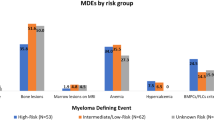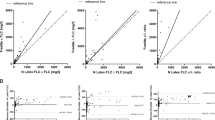Abstract
Auto-SCT (ASCT) is widely used in first-line treatment of multiple myeloma (MM). However, most patients eventually relapse or have progression of disease (R/POD). Although precise knowledge of R/POD patterns would be important to generate evidence-based surveillance recommendations after ASCT, such data is limited in the literature, especially after introduction of the free light chain assay (FLCA). This retrospective study examined the patterns of R/POD after first-line ASCT in 273 patients, using established criteria. At the time of R/POD, only 2% of patients had no associated serological evidence of R/POD. A total of 85% had asymptomatic R/POD, first detected by serological testing, whereas 15% had symptomatic R/POD with aggressive disease, early R/POD and short survival, with poor cytogenetics and younger age identified as risk factors. Although occult skeletal lesions were found in 40% of asymptomatic patients tested following serological R/POD, yearly skeletal surveys and urine testing were poor at heralding R/POD. We found a consistent association between paraprotein types at diagnosis and R/POD, allowing informed recommendations for appropriate serological monitoring and propose a new needed criterion using FLCA for patients relapsing by FLC only. Our findings provide important evidence-based recommendations that strengthen current monitoring guidelines after first-line ASCT in MM.
This is a preview of subscription content, access via your institution
Access options
Subscribe to this journal
Receive 12 print issues and online access
$259.00 per year
only $21.58 per issue
Buy this article
- Purchase on Springer Link
- Instant access to full article PDF
Prices may be subject to local taxes which are calculated during checkout



Similar content being viewed by others
References
Cavo M, Rajkumar SV, Palumbo A, Moreau P, Orlowski R, Blade J et al. International Myeloma Working Group consensus approach to the treatment of multiple myeloma patients who are candidates for autologous stem cell transplantation. Blood 2011; 117: 6063–6073.
Engelhardt M, Udi J, Kleber M, Spencer A, Rocci A, Knop S et al. European Myeloma Network: the 3rd Trialist Forum Consensus Statement from the European experts meeting on multiple myeloma. Leuk Lymphoma 2010; 51: 2006–2011.
Anderson KC, Alsina M, Bensinger W, Biermann JS, Chanan-Khan A, Cohen AD et al. NCCN clinical practice guidelines in oncology: multiple myeloma. J Natl Compr Cancer Netw 2009; 7: 908–942.
Harousseau JL, Moreau P . Autologous hematopoietic stem-cell transplantation for multiple myeloma. N Engl J Med 2009; 360: 2645–2654.
Palumbo A, Anderson K . Multiple myeloma. N Engl J Med 2011; 364: 1046–1060.
Laubach JP, Schlossman RL, Mitsiades CS, Anderson KC, Richardson PG . Thalidomide, lenalidomide and bortezomib in the management of newly diagnosed multiple myeloma. Expert Rev Hematol 2011; 4: 51–60.
Laubach J, Richardson P, Anderson K . Multiple myeloma. Annu Rev Med 2011; 62: 249–264.
Bradwell AR, Carr-Smith HD, Mead GP, Tang LX, Showell PJ, Drayson MT et al. Highly sensitive, automated immunoassay for immunoglobulin free light chains in serum and urine. Clin Chem 2001; 47: 673–680.
Dispenzieri A, Kyle R, Merlini G, Miguel JS, Ludwig H, Hajek R et al. International Myeloma Working Group guidelines for serum-free light chain analysis in multiple myeloma and related disorders. Leukemia 2009; 23: 215–224.
Katzmann JA, Clark RJ, Abraham RS, Bryant S, Lymp JF, Bradwell AR et al. Serum reference intervals and diagnostic ranges for free kappa and free lambda immunoglobulin light chains: relative sensitivity for detection of monoclonal light chains. Clin Chem 2002; 48: 1437–1444.
Alegre A, Granda A, Martinez-Chamorro C, Diaz-Mediavilla J, Martinez R, Garcia-Larana J et al. Different patterns of relapse after autologous peripheral blood stem cell transplantation in multiple myeloma: clinical results of 280 cases from the Spanish Registry. Haematologica 2002; 87: 609–614.
Lenhoff S, Hjorth M, Turesson I, Westin J, Gimsing P, Wisloff F et al. Intensive therapy for multiple myeloma in patients younger than 60 years. Long-term results focusing on the effect of the degree of response on survival and relapse pattern after transplantation. Haematologica 2006; 91: 1228–1233.
Avet-Loiseau H . Role of genetics in prognostication in myeloma. Best Pract Res Clin Haematol 2007; 20: 625–635.
Dimopoulos M, Kyle R, Fermand JP, Rajkumar SV, San Miguel J, Chanan-Khan A et al. Consensus recommendations for standard investigative workup: report of the International Myeloma Workshop Consensus Panel 3. Blood 2011; 117: 4701–4705.
Rajkumar SV, Harousseau JL, Durie B, Anderson KC, Dimopoulos M, Kyle R et al. Consensus recommendations for the uniform reporting of clinical trials: report of the International Myeloma Workshop Consensus Panel 1. Blood 2011; 117: 4691–4695.
Durie BG, Harousseau JL, Miguel JS, Blade J, Barlogie B, Anderson K et al. International uniform response criteria for multiple myeloma. Leukemia 2006; 20: 1467–1473.
Team RDC R: A language and environment for statistical computing. R Foundation for Statistical Computing: Vienna, Austria, 2011.
Kumar S, Mahmood ST, Lacy MQ, Dispenzieri A, Hayman SR, Buadi FK et al. Impact of early relapse after auto-SCT for multiple myeloma. Bone Marrow Transplant 2008; 42: 413–420.
Bradwell AR, Harding SJ, Fourrier NJ, Wallis GL, Drayson MT, Carr-Smith HD et al. Assessment of monoclonal gammopathies by nephelometric measurement of individual immunoglobulin kappa/lambda ratios. Clinical Chem 2009; 55: 1646–1655.
Donato LJ, Zeldenrust SR, Murray DL, Katzmann JA . A 71-year-old woman with multiple myeloma status after stem cell transplantation. Clinical Chem 2011; 57: 1645–1648.
Dawson MA, Patil S, Spencer A . Extramedullary relapse of multiple myeloma associated with a shift in secretion from intact immunoglobulin to light chains. Haematologica 2007; 92: 143–144.
Kuhnemund A, Liebisch P, Bauchmuller K, zur Hausen A, Veelken H, Wasch R et al. Light-chain escape-multiple myeloma'-an escape phenomenon from plateau phase: report of the largest patient series using LC-monitoring. J Cancer Res Clin Oncol 2009; 135: 477–484.
Walker R, Barlogie B, Haessler J, Tricot G, Anaissie E, Shaughnessy JD et al. Magnetic resonance imaging in multiple myeloma: diagnostic and clinical implications. J Clin Oncol 2007; 25: 1121–1128.
Nowrousian MR, Brandhorst D, Sammet C, Kellert M, Daniels R, Schuett P et al. Serum free light chain analysis and urine immunofixation electrophoresis in patients with multiple myeloma. Clin Cancer Res 2005; 11: 8706–8714.
Singhal S, Stein R, Vickrey E, Mehta J . The serum-free light chain assay cannot replace 24-hour urine protein estimation in patients with plasma cell dyscrasias. Blood 2007; 109: 3611–3612.
Dispenzieri A, Zhang L, Katzmann JA, Snyder M, Blood E, Degoey R et al. Appraisal of immunoglobulin free light chain as a marker of response. Blood 2008; 111: 4908–4915.
Katzmann JA, Dispenzieri A, Kyle RA, Snyder MR, Plevak MF, Larson DR et al. Elimination of the need for urine studies in the screening algorithm for monoclonal gammopathies by using serum immunofixation and free light chain assays. Mayo Clinic Proc 2006; 81: 1575–1578.
Author information
Authors and Affiliations
Corresponding author
Ethics declarations
Competing interests
The authors declare no conflict of interest.
Additional information
Prior presentation of data: American Society of Hematology (ASH) Meeting 2011, Abstract 38460; San Diego, CA, USA.
Rights and permissions
About this article
Cite this article
Zamarin, D., Giralt, S., Landau, H. et al. Patterns of relapse and progression in multiple myeloma patients after auto-SCT: implications for patients’ monitoring after transplantation. Bone Marrow Transplant 48, 419–424 (2013). https://doi.org/10.1038/bmt.2012.151
Received:
Revised:
Accepted:
Published:
Issue Date:
DOI: https://doi.org/10.1038/bmt.2012.151
Keywords
This article is cited by
-
Optimal timing of treatment at relapse after autologous stem cell transplantation in patients with multiple myeloma: a study of the Korean Multiple Myeloma Working Party (KMM-1909)
Bone Marrow Transplantation (2022)
-
Expert Panel Consensus Statement for Proper Evaluation of First Relapse in Multiple Myeloma
Current Hematologic Malignancy Reports (2019)
-
Management of relapsed and refractory multiple myeloma: novel agents, antibodies, immunotherapies and beyond
Leukemia (2018)
-
Real-world data on Len/Dex combination at second-line therapy of multiple myeloma: treatment at biochemical relapse is a significant prognostic factor for progression-free survival
Annals of Hematology (2018)
-
Clinical course and outcomes of patients with multiple myeloma who relapse after autologous stem cell therapy
Bone Marrow Transplantation (2016)



